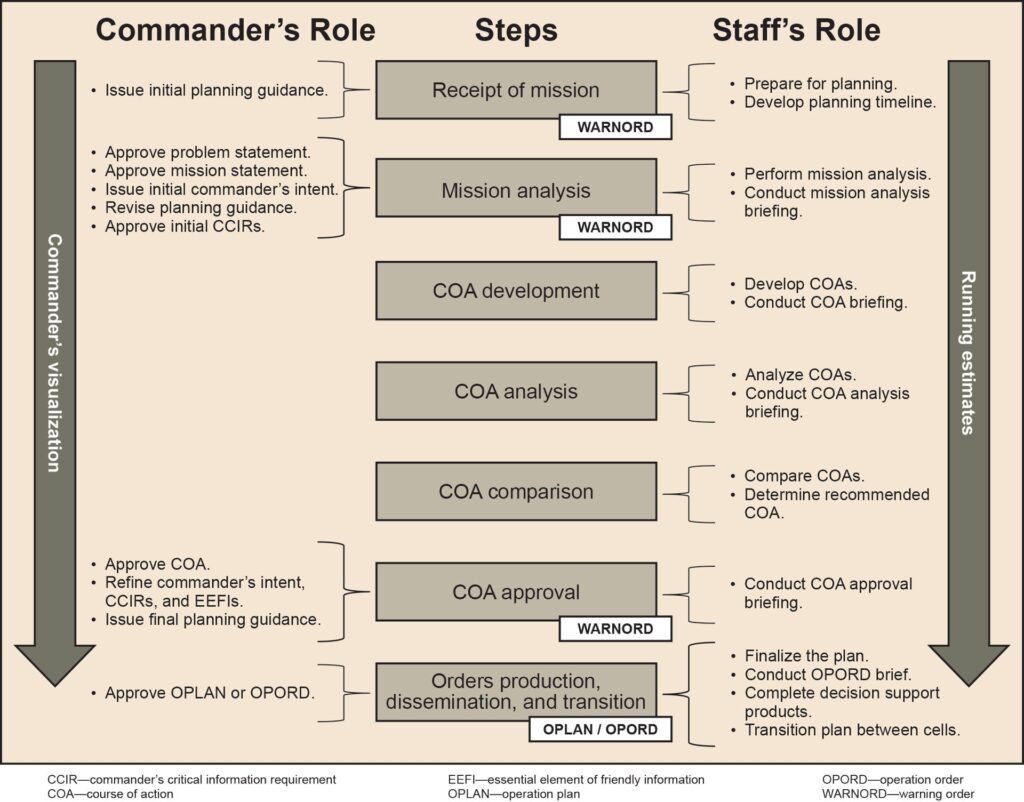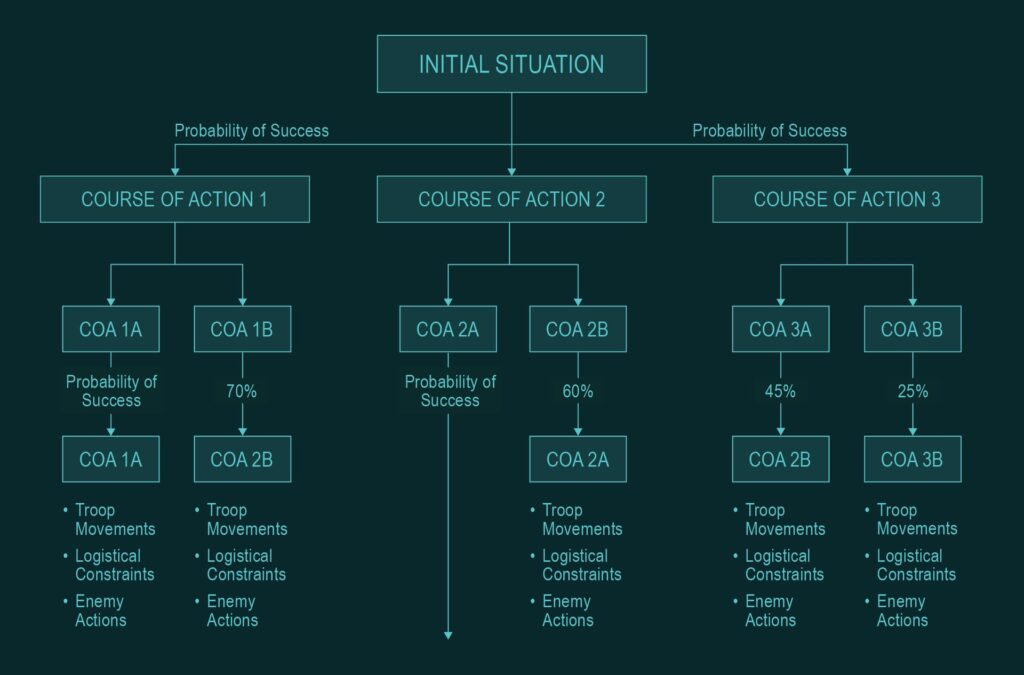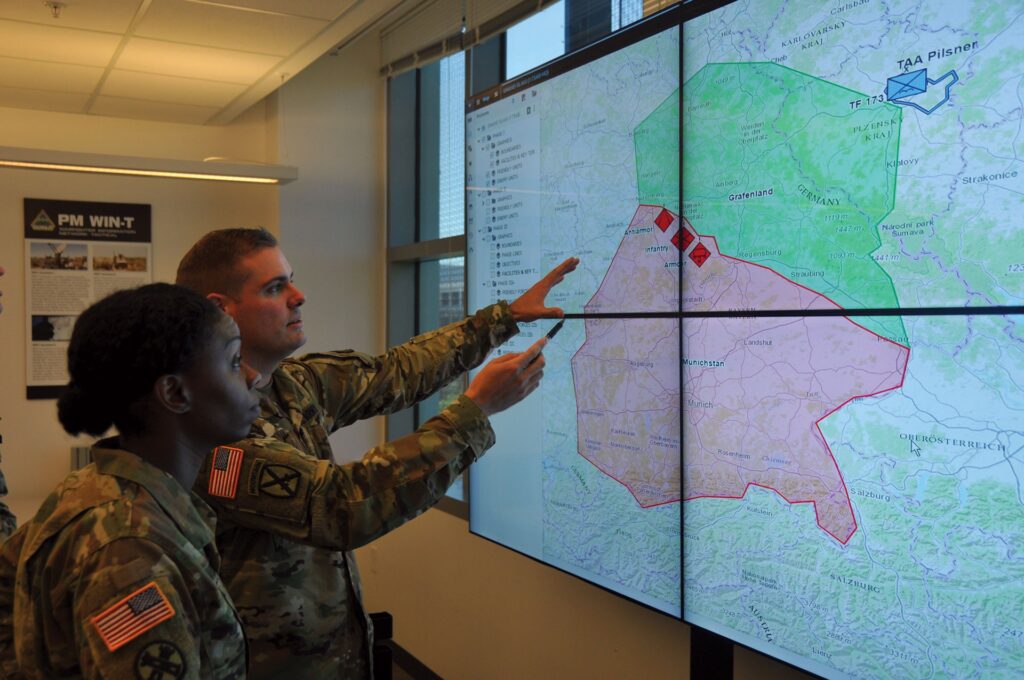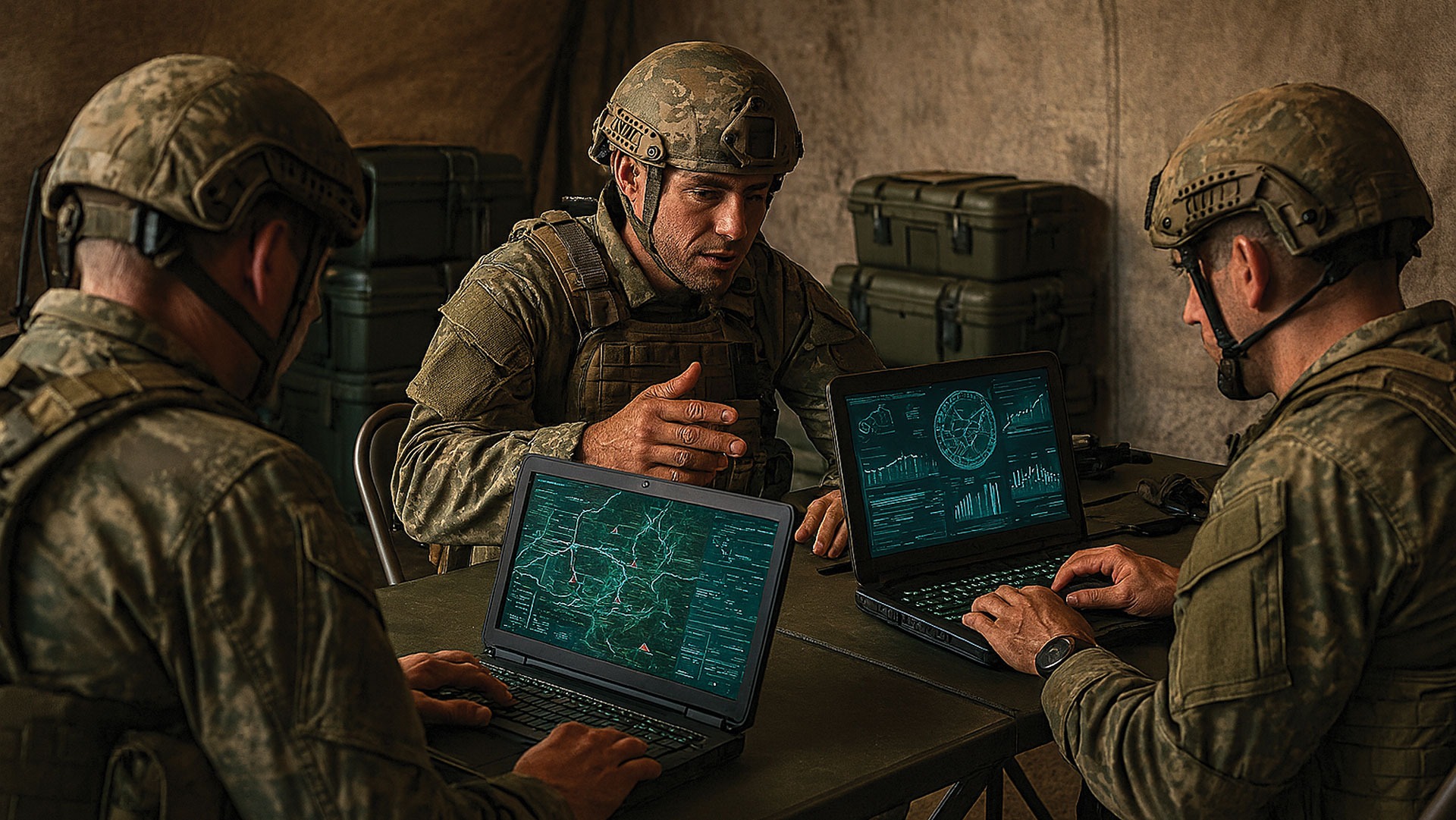En una era donde la guerra algorítmica se está convirtiendo rápidamente en una realidad, la velocidad en la toma de decisiones será el factor decisivo entre la victoria y la derrota para el Ejército de los EE. UU. El futuro campo de batalla estará definido por el rápido ritmo de las operaciones impulsadas por la inteligencia artificial (IA), lo que exige un cambio fundamental en la forma en que el Ejército planifica la guerra. Este panorama en rápida evolución, impulsado por la agresiva búsqueda de IA por parte de los adversarios, presenta tanto una oportunidad crítica como un desafío significativo para el Ejército de los EE.UU. Los adversarios casi iguales, en particular China y Rusia, reconocen el potencial de la IA para transformar las operaciones militares y la están buscando agresivamente.
In an era where algorithmic warfare is rapidly becoming a reality, the speed of decision-making will be the deciding factor between victory and defeat for the U.S. Army. The future battlefield will be defined by the rapid tempo of artificial intelligence (AI)-driven operations, demanding a fundamental shift in how the Army plans for war. This rapidly evolving landscape, driven by adversaries’ aggressive pursuit of AI, presents both a critical opportunity and a significant challenge for the U.S. Army. Near-peer adversaries, particularly China and Russia, recognize AI’s potential to transform military operations and are aggressively pursuing it.1 These nations have stated their intentions to leverage AI for military advantage by enhancing the speed, reach, precision, and lethality of their operations, potentially achieving decision dominance.2 To maintain overmatch in this rapidly evolving landscape, the U.S. Army must urgently modernize its legacy planning frameworks, specifically the military decision-making process (MDMP), to effectively integrate AI capabilities.
This article examines how narrow AI, the most readily available and practically applicable form of AI, can support and enhance MDMP within the next five to ten years. This can be accomplished through a measured and phased approach that incorporates rigorous experimentation, robust safeguards, and a focus on edge computing solutions for tactical units. Such actions are essential for the U.S. Army to harness AI’s potential while mitigating its inherent risks. The article concludes with a discussion of potential applications and limitations while focusing on practical integration concerns.
The Military Decision-Making Process
The MDMP serves as the U.S. Army’s foundational planning methodology.3 It provides a structured framework for commanders and their staff to understand the operational environment (OE), develop courses of action (COA), and make informed decisions. While MDMP offers a valuable structured approach, its effectiveness is increasingly challenged by the growing complexity and tempo of modern operations, particularly in the context of multidomain operations.4 The increasing volume and velocity of data generated in modern warfare and the need for rapid decision-making strain the capacity of traditional, analog planning processes. The seven steps of MDMP, from receipt of mission to orders production, demand significant time and resources, often exceeding that available in dynamic OEs. This often restricts the staff’s capacity to thoroughly explore the full spectrum of potential enemy and friendly actions, a critical limitation when confronting adversaries leveraging AI-enabled systems for accelerated decision-making.5 Integrating near-term AI capabilities can significantly mitigate these challenges and enhance the speed, efficiency, and ultimately, the effectiveness of MDMP in the face of twenty-first-century warfare.

Incorporating AI into the MDMP
AI offers the potential to revolutionize the MDMP, significantly enhancing its speed, efficiency, and adaptability in the face of the complexity of modern warfare. Integrating AI capabilities into key steps of MDMP can empower commanders and staff with enhanced understanding of the battlefield, a more robust COA development and analysis, and a streamlined orders production process. Specifically, the U.S. Army should leverage AI to improve the following critical phases of MDMP:
- Mission analysis. AI algorithms can rapidly process and analyze vast amounts of data from diverse sources, including intelligence reports, sensor feeds, and open-source information, providing commanders with a more comprehensive and nuanced understanding of the OE. Predictive algorithms, leveraging historical data and real-time intelligence, can forecast enemy movements, identify high-payoff targets, and estimate logistical requirements with greater accuracy.8 This enhanced situational awareness enables commanders to make more informed decisions based on a richer battlespace understanding. For example, AI could analyze terrain data, weather patterns, and enemy order of battle information to identify likely enemy avenues of approach, potential ambush locations, and optimal positions for friendly forces.

- COA development. AI can generate a broader spectrum of COAs by considering a greater number of factors and permutations than is feasible with traditional manual methods.9 This expands the range of planning options and allows staff to explore more creative and potentially unconventional approaches. AI algorithms can also assist in synchronizing various elements of a plan, such as maneuver, fires, and intelligence, and developing detailed timelines for each COA, thereby optimizing resource allocation and timing. For instance, AI could generate multiple COAs based on different assumptions about enemy intentions, friendly force capabilities, and logistical constraints, allowing planners to quickly compare the advantages and disadvantages of each option.
- COA analysis. AI-driven simulations can rapidly assess the feasibility and risks associated with each COA by incorporating factors such as enemy capabilities, terrain, weather, and logistical constraints.10 This allows for more robust analysis and identification of potential friction points, enabling planners to develop more resilient and adaptable plans. AI can run thousands of simulated war games, exploring a wide range of potential outcomes and identifying vulnerabilities or opportunities that might be missed in traditional manual war games. This enhanced analysis enables planners to refine COAs, develop contingency plans, and select the COA with the highest probability of success given the anticipated conditions.
- COA comparison. AI can augment COA comparison by providing quantitative assessments of success probability for each option, supplementing the commander’s judgment and experience with data-driven insights. Tools like “Sketch to Decide,” developed from Project Deep Green, allow for interactive exploration of branching scenarios and can further aid in visualizing potential outcomes and understanding the ramifications of each COA.11 By combining quantitative assessments with qualitative judgments, commanders can make better informed decisions based on a more complete understanding of the potential risks and benefits of each option.12
- Orders production. AI can automate many routine tasks associated with orders production, such as formatting, ensuring compliance with doctrinal terminology, and even drafting specific sections of the order based on predefined templates and input parameters. This automation frees staff to focus on higher-level planning, coordination, and refinement of the chosen COA, ensuring that orders are clear, concise, and accurately reflect the commander’s intent. AI-powered tools can also assist in disseminating orders quickly and efficiently, ensuring that all relevant units receive the necessary information in a timely manner.
By strategically integrating AI into these key steps, MDMP can evolve into a more agile and adaptive process, better suited to the complexities and accelerated tempo of modern military operations. This transformation will require a shift in mindset, embracing AI not as a replacement for human judgment but as a powerful tool that can augment and enhance human capabilities.
Near-Future AI Capabilities
Narrow AI offers the most immediate and practical opportunity for enhancing MDMP within the next five to ten years. Narrow AI systems excel at executing specific, well-defined tasks within a predetermined scope of execution criteria and expectations about environmental interactions.13 Although limited in their generalizability and lacking the broad cognitive abilities of hypothetical artificial general intelligence, narrow AI systems can be readily integrated into current planning software to automate routine tasks, such as data collection and analysis, orders formatting, and sections of the orders production process.14 This automation frees valuable staff time and cognitive bandwidth, allowing planners to concentrate on higher-level cognitive tasks requiring human judgment, creativity, and critical thinking.
Machine learning (ML) is a specific type of AI that is fed a stream of data from which the model incrementally learns and adapts over time in an iterative process.15 Several relevant ML techniques hold promise for near-term integration into MDMP:
- Supervised learning. Supervised learning uses labeled datasets to train algorithms for predictive analysis, forecasting enemy movements based on historical data and current intelligence.16 It can estimate logistical requirements based on operational parameters and anticipated consumption rates, and assess potential risks associated with various COAs by considering factors like enemy capabilities, terrain, and weather. This data-driven approach offers a more quantitative and less subjective risk assessment compared to traditional methods, potentially reducing bias and improving the accuracy of risk assessments. Examples of supervised learning applications within MDMP include predicting enemy force movements based on terrain analysis and previous patterns of activity, forecasting fuel consumption rates based on unit composition and planned maneuvers, and estimating casualty rates based on historical data and engagement predictions.
- Unsupervised learning. This technique excels at identifying patterns and relationships in unlabeled data, enabling the grouping and analysis of complex information sets, including terrain data, mobility corridors, and potential OEs.17 This capability can significantly assist in COA development and comparison, expanding the range of options considered and potentially identifying novel approaches that human planners might overlook. For example, unsupervised learning could be used to cluster similar terrain features together, identifying potential avenues of approach for enemy forces or optimal locations for defensive positions. It could also be used to analyze historical weather patterns to predict future conditions and inform planning assumptions.18
- Semi-supervised learning. Combining labeled and unlabeled data, this technique offers a cost-effective approach to training AI systems, particularly in scenarios where labeled data is scarce, expensive to acquire, or time-consuming to generate.19 Semi-supervised learning can enhance the mission analysis phase by analyzing a wider range of data sources, potentially exposing unforeseen aspects of the enemy or environment, thus improving situational awareness. For instance, a semi-supervised learning model could be trained on a limited set of labeled satellite imagery to identify specific enemy equipment and then applied to a larger set of unlabeled imagery to identify potential enemy concentrations or logistical hubs.
- Reinforcement learning. Reinforcement learning is akin to instrumental conditioning in physiology, where the AI learns to associate stimulus and response. This technique trains large language learning models to optimize their behavior through trial and error, making it well-suited for dynamic, complex environments like COA analysis and war games.20 Reinforcement learning can identify potential friction points in a plan, recommend refinements to improve synchronization and timing, and ultimately optimize execution timelines by simulating numerous iterations and identifying potential bottlenecks or vulnerabilities.21 For example, reinforcement learning could be used to optimize the movement of units during a complex attack to minimize exposure to enemy fire while maximizing speed and effectiveness. It could also be used to refine logistical plans to ensure that supplies and resources are available at the right place and time.
Near-Future Limitations of Narrow AI
Despite the potential benefits, narrow AI has inherent limitations that must be carefully considered during its integration into MDMP. These systems are fundamentally data dependent, meaning their performance is inextricably linked to the quality, quantity, and representativeness of the data used for training.22 This dependence can lead to several challenges that must be addressed through careful design, testing, and oversight:
- Brittleness. AI models trained on specific datasets may struggle to adapt to unanticipated circumstances or dynamic changes in the OE, potentially generating inaccurate or irrelevant recommendations.23 This necessitates continuous model refinement and adaptation based on real-world data, ensuring that AI systems remain relevant and effective in the face of evolving threats and changing conditions.24 Furthermore, robust testing and evaluation procedures, including simulated and live exercises, are essential to identify potential vulnerabilities and improve the resilience of AI systems.
- Unexplainability. The “black box” nature of certain AI algorithms can obscure the reasoning behind their outputs, hindering trust among military planners and potentially masking underlying biases in the data or the algorithm itself.25 Transparency and explainability are crucial for building confidence and ensuring responsible use. Efforts to develop more explainable AI algorithms, which provide insights into their decision-making processes, are essential for fostering trust and allowing human planners to understand and validate AI-generated recommendations.26
- Bias. AI systems can inherit and amplify biases present in the training data, leading to skewed analyses and potentially flawed or even discriminatory COAs.27 Rigorous testing and evaluation for bias using diverse and representative datasets are essential to mitigate this risk. Furthermore, ongoing monitoring and evaluation of AI systems in OEs are necessary to identify and address any emergent biases that may arise due to unforeseen interactions or changing data distributions.28
The inherent limitations in current narrow AI underscore the importance of carefully curating and evaluating data sources, implementing rigorous testing and validation procedures, and maintaining the crucial role of human oversight in AI-assisted military planning. Addressing these challenges is paramount for fostering trust and ensuring that AI genuinely enhances, rather than hinders, the decision-making process. Ultimately, the goal is to create a symbiotic relationship between human planners and AI systems, leveraging the strengths of each to achieve optimal outcomes.
Current Efforts to Integrate AI into Planning
The U.S. Department of Defense (DOD) has a nearly sixty-year history of experimentation with AI, and previous efforts paved the way for recent advancements in the field.29 Prior studies explored using AI to address MDMP challenges related to intelligence preparation, COA development, and COA analysis.30 They also demonstrated AI’s potential to significantly expedite the planning process.31 Ultimately, the U.S. Army abandoned each of these previous efforts because the technology was not at a sufficient level to survive on the battlefield. However, the recent advancements in AI and ML demonstrate that now is the time to advance the discussion of how best to integrate AI into MDMP.

The Army continues to build upon previous efforts to integrate AI into planning with a long-term vision to modernize its planning and decision-making processes. As outlined in the 2023 Data, Analytics and Artificial Intelligence Adoption Strategy, the U.S. Army’s current efforts are nested with the DOD’s.32 Key aspects of the DOD plan are quality data, insightful analytics, and responsible AI. This framework aims to build an enduring decision advantage for the U.S. military. The Army’s Project Manager Mission Command has fielded new AI-powered tools, including the Command Post Computing Environment (CPCE) and the Automated Planning Framework (APF).33 These tools offer commanders enhanced situational awareness, improved decision-making, and a unified battlefield view.
The CPCE replaced the Command Post of the Future in 2019, providing a unified battlefield view and, most importantly, consolidating mission command systems into a single user interface. However, the CPCE alone is insufficient to leverage AI’s full potential for MDMP. APF complements the CPCE by using AI/ML to generate and evaluate COAs based on the situation, resources, objectives, and constraints.34 It identifies the optimal COA by analyzing success probability, resource costs, and mission impacts. The APF then generates detailed execution plans for the selected COA. By jointly deploying the APF and CPCE, it could streamline planning, accelerate COA development, and enhance multi-option evaluation beyond the CPCE’s capabilities alone.
The Army’s current initiatives to integrate AI into MDMP demonstrate a concerted effort to modernize planning and leverage cutting-edge technologies. Tools like the CPCE and APF offer enhanced situational awareness, unified battlefield visualization, and AI-powered COA development and evaluation.35 However, these programs are still in their infancy. While they promise to address many of the challenges to MDMP, their benefits are yet to be fully realized.
Ultimately, successful implementation hinges on building trust in these systems among commanders and staff. Rigorous testing, user feedback, and incremental capability rollouts will ensure AI-enabled planning tools provide real operational value. Techniques like semi-supervised learning could help these planning AI systems continuously improve from real-world operational experience without relying on heavily curated datasets. As the Army continues refining its AI integration strategy, balancing the imperative to embrace new technologies with the operational realities and human-machine teaming requirements of modern warfare will determine the ultimate impact.
Challenges and Recommendations for AI Implementation into MDMP
Potential adversaries of the U.S. Army understand the requirement for stable connectivity essential for AI-enabled planning tools and will take actions to disrupt the network. Near-peer competitors will contest the electromagnetic (EM) spectrum and employ layered standoff, direct fire, and cyber tools to degrade friendly command-and-control systems. Russian and Chinese doctrine directly targets satellite links, radio connections, and Wi-Fi capacity through jamming, spoofing, directed energy weapons, and other means.36 Headquarter nodes must restrict emissions whenever possible, relying on fleeting burst transmissions to avoid becoming an enemy target.37 Tactical formations face even more significant challenges. Battalions and brigades maneuvering on the future battlefield against capable threat forces must frequently break contact with enterprise networks to avoid detection and targeting.38 These units will have limited windows for syncing drone feeds, updating datasets, or reaching back to higher headquarters for intelligence to plan future missions.
Integrating AI capabilities into the planning process during large-scale combat operations against peer adversaries will prove exceptionally challenging, given the contested and constrained nature of future OEs mentioned above. Lt. Gen. Ted Martin, then–deputy commanding general of the U.S. Army Training and Doctrine Command, outlined his vision of the future OE in 2019. He posited that the future OE for the U.S. Army is characterized by denied or degraded access to the EM, a transparent battlefield due to the ubiquitous fielding of sensors, and breakneck changes in science and technology.39 Three primary factors complicate but necessitate the adoption of AI to maintain battlefield dominance: EM spectrum degradation, dispersed and impermanent communications architectures, and constant maneuver.40 Effective employment of AI tools into the planning process will require balancing bandwidth availability, signature reduction, and mobility.41
Fielding combat cloud technologies and leveraging autonomous systems may mitigate some EM spectrum risks to U.S. Army units actively using AI-enabled planning tools. ML algorithms demand massive, continuous data flows, which makes constantly connected AI impossible, given bandwidth limitations within tactical formations.42 Leading AI platforms require 3.6 terabits per second of networking bandwidth, greatly exceeding any capabilities resident in U.S. Army tactical formations.43
Edge computing offers a solution to the problem of using AI-assisted planning tools within U.S. Army units in a contested EM environment and limited by bandwidth constraints. The term edge computing refers to a distributed computing paradigm that brings computation and data storage closer to the location where it is needed to improve response times and save bandwidth.44 Operating “at the edge,” perhaps isolated entirely from U.S. Army enterprise cloud connection, poses implementation challenges but may be the best opportunity to put AI planning tools into the hands of tactical commanders while mitigating the risk of being targeted in the EM.45 Compressing and scrubbing data suites locally before conveying only essential elements for cloud-based processing presents one option.46 Model compression refers to techniques that reduce the size of neural networks to improve efficiency. Two main approaches are quantization that decreases the number of bits used to represent each weight and pruning that removes unimportant connections.47 This leads to lower computation and memory requirements with a potential slight loss in accuracy.48 Edge computing offers Army units the opportunity to conduct AI-enabled MDMP in an OE with a contested EM spectrum.
The constant maneuver essential for survivability against modern multidomain fires also impacts the application of AI into the planning process.49 Sensor-shooter links enable collaborative weapons systems, predictive logistics, positional awareness, targeting support, and other tools that depend on stable coordination among maneuvers, fires, and intelligence assets.50 Pairs and groups of tactical units routinely transitioning in and out of the mutual support range face difficulties establishing the data-sharing foundation for some AI capabilities. Advanced computing partly compensates through simulation and projection, but ultimately, tactical platforms require proximity to communicate with each other and maximize networked functionality.51 Edge computing has the potential to dramatically lower bandwidth requirements, however, the lifespan for data sharing between any given set of entities will likely span minutes rather than hours due to the fast-paced nature of the future battlefield.52
Realizing the full potential of integrating AI into the planning process necessitates balancing signature reduction priorities, managing communications limitations imposed by aggression and maneuvers, and innovating data transport mechanisms and analytics refined to a narrow bandwidth.53 Through extensive experimentation and gradual adoption of technologies proven reliable in constrained settings, AI can help overcome the fog and friction of warfare. U.S. Army leaders must understand that replicating the plug-and-play capabilities touted in the pristine conditions of tech conventions is not feasible. The immutable realities of the anticipated denied, degraded, intermittent, and limited environment challenges the planning assumptions of the U.S. Army. Their planners face a future that is more lethal, ill-structured, adversarial, and constantly fluctuating.54 To succeed on the future battlefield, the U.S. Army must prioritize the incremental expansion of narrow AI solutions deployable at the edge, enabling effective MDMP in the face of technologically advanced adversaries.
Combat brigades and battalions require stand-alone AI planning applications refit for intermittent access to external data. Offline ML software specialized for planning and procedural tasks would leverage onboard sensors and a compressed version of the common operational picture loaded before severing broader network access. AI algorithms sustained by the Common Tactical Server or vehicle-based systems would function in internal combat networks. New data feeds from aerial surveillance assets or other formations could rapidly update the system when communications allow based on the enemy threat or established communication windows. Suites of models optimized for high usability regardless of connectivity allow planning cells to benefit from advanced, collaborative analytics tailored for the bandwidth-limited “tactical edge.”
Above division echelon, campaign quality network infrastructure combined with a combat cloud architecture offers organizational planning capabilities approaching the commercial state of the art.55 Fully online AI planning tools provide automation, knowledge management, and visualization enablers supported by data in near-real-time thanks to fiber links and satellite connectivity. Dedicated training suites drawing on integrated sensors across multiple domains keep complex algorithms optimized for one another and the evolving common operational picture. Expert-in-the-loop machine learning techniques ensure that planning tools adapt to new weapons, enemy tactics, techniques, and procedures, or mission sets. The results of these actions are updated datasets, leading to improved mission analysis and better war-gaming of anticipated enemy COAs.
The U.S. Army must ensure extensive “ground truthing” to maintain trust in predictive outputs even as artificial neural networks hunt emergent patterns. Ground truthing is best described as the ongoing process of checking machine learning model predictions against real-world observations to validate accuracy.56 Continual collection and confirmation of results build reliability so insights autonomously detected by AI reflect the complex dynamics of the environment.57 These outputs could then feed MDMP during the mission analysis step as the staff seeks to understand the OE.
The hybrid approach of AI incorporation described above empowers the tactical edge and ensures that U.S. Army units can leverage technology and enhance the MDMP. It does this through specialized offline-capable machine learning applications combined with enhanced capabilities employed by upper echelons. Realizing this potential requires phased integration of AI that overcomes bandwidth and signature limitations to enable systemwide impact. Only a phased, threat-conscious integration process for AI allows its promise to overcome rather than compound future battlefield friction.
Conclusion
The successful incorporation of AI into MDMP necessitates a deliberate, phased approach grounded in continuous experimentation and rigorous testing. This involves not only prioritizing the development of robust AI algorithms tailored to specific MDMP steps but also modernizing communication networks, CPCEs, and other supporting infrastructure. Furthermore, building trust and confidence in these new technologies among senior commanders and staff is crucial for successful adoption. This requires transparent development processes, clear explanations of AI capabilities and limitations, and ongoing opportunities for user feedback and input. By thoughtfully integrating AI capabilities while preserving human judgment at the core of decision-making, the U.S. Army can harness AI’s potential to enhance planning efficiency, improve analytical capabilities, and enable more agile and adaptive operations within the complex, multidomain battlespace. Failure to do so risks ceding a decisive advantage to those adversaries actively pursuing AI integration into their own military planning processes.
Fuente: https://www.armyupress.army.mil


